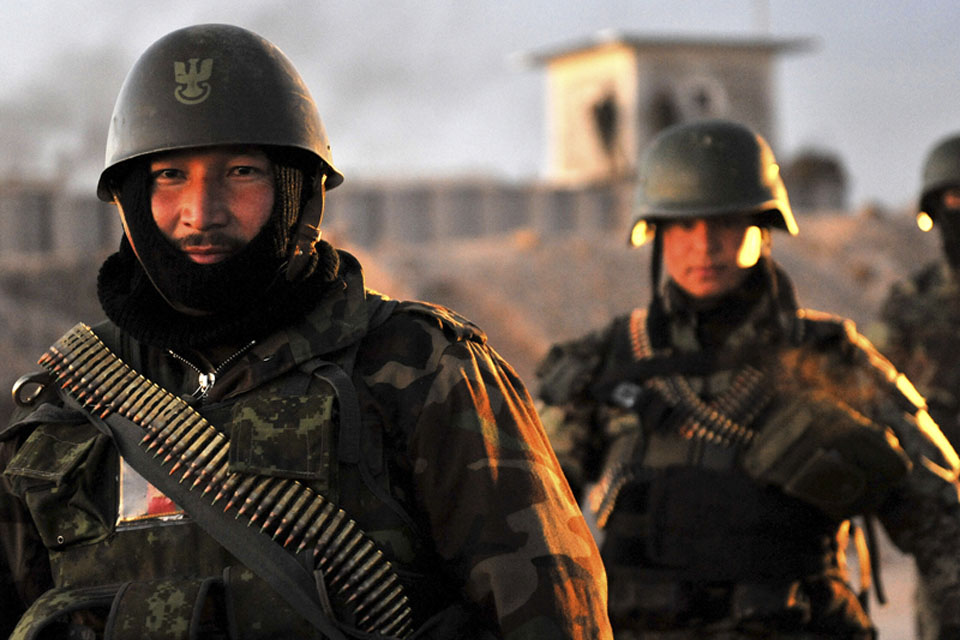UK soldiers help Afghan-led operation disrupt insurgents
British soldiers from 2nd Battalion The Rifles (2 RIFLES) have helped Afghan security forces in an operation to clear insurgents from an area close to Gereshk in Nahr-e Saraj district, Helmand province.

Afghan National Army warriors on patrol in the Bowri Dashte to the west of Gereshk [Picture: Sergeant Steve Blake RLC, Crown Copyright/MOD 2012]
Around 1,000 soldiers and police from the Afghan National Security Forces cleared an area known as the Bowri Dashte to the west of Gereshk.
The Dashte is open country with scattered settlements just outside the verdant Green Zone, which runs alongside the Helmand River.
The forces - made up of 850 Afghan National Army (ANA) warriors and 80 Afghan Uniform Police - were joined by 250 British soldiers from 2 RIFLES and other regiments, who acted in an advisory role.
British troops are deployed in three districts of Helmand province and Nahr-e Saraj is the last where Task Force Helmand retains the lead for security following the transition of Nad ‘Ali and Lashkar Gah.
Brigadier General Sherin Shah is the commander of the ANA’s 3/215 Brigade, which planned and led the operation. He said:
The aim of this operation was to clear through the Dashte area west of Gereshk to disrupt the insurgents. We are bringing security to an area that did not have it before, an area that is close to Highway One, which is a key economic and trading route here.
It has been a good operation and my warriors have done very well. They have been well-trained and prepared for this and have moved fast through the area, recovering a large quantity of bomb-making equipment.
Lieutenant Colonel Bill Wright, the Commanding Officer of 2 RIFLES, which heads the Brigade Advisory Group that assists 3/215 Brigade, said:
The ANA designed, planned and launched this operation in response to the district governor’s security concerns, right into an area previously regarded as an insurgent safe haven.
One of our challenges has been keeping pace with the ANA. When they take ownership of something they are very quick to respond. For example, to conceive, plan and launch a brigade-level operation like this one in a week is extremely difficult, even for ISAF forces.
The key thing the ANA have is extremely good local knowledge, and the ability to interact freely with the local population and come up with Afghan solutions to Afghan issues.

Afghan National Army warriors deployed on Operation HORHARI AFGHAN [Picture: Sergeant Steve Blake RLC, Crown Copyright/MOD 2012]
Captain Alex Grubb, from B Squadron of the Queen’s Royal Hussars, works as one of the advisors to the Afghan National Army. He said:
In the time I have worked with the ANA they have improved in many areas. They still have a way to go in some more specialist fields, but in terms of basic soldier skills and drills and their bravery and willingness to take on the enemy they have not been found wanting.
I’ve been impressed how quickly the ANA formed up and how fast they moved, keeping formation, to achieve the aim of the operation. It really does show how far they have come and their growing capability.
Captain Giles Walsh, from 1st Battalion The Princess of Wales’s Royal Regiment (1 PWRR), has been advising the local Afghan Uniform Police (AUP) Commander Mohammed Wali. He said:
Throughout the operation Mohammed Wali engaged with the locals, receiving lunch and lodgings as well as information about the insurgent withdrawal routes from the area. Despite the Bowri not having a firm connection to the Afghan Government, Mohammed Wali was recognised and welcomed by many of the residents.
The success of the operation has renewed the AUP’s vigour for further operations and Mohammed Wali is determined to drive insurgents out of this area.